
Occupational therapy (ICAN)
We work with children and young people who experience challenges with daily activities due to additional needs.
About our occupational therapy service
Operating as part of the integrated children’s additional needs (ICAN) service, our mission is to support children and young people with additional needs to participate in everyday activities and situations at home, school and in the community.
We aim to help children and young people do the things that are important to them, like leisure activities with friends and family, taking care of themselves and joining in with school day.
Who’s it for?
We work with children and young people aged 0 to 19 with additional needs. This could be children with a complex physical or learning needs. We also see children who may not have a diagnosis but have difficulties which are impacting on their day to day activities.
We do not see children and young people with neuromuscular conditions, juvenile arthritis or acute brain injuries. We do not see children where behavioural issues are the main barrier to participation and do not carry out sensory integration therapy.
What we offer
- We have a combination of offers dependent on your child’s need. These may include webinars and online resources, telephone consultations or face to face appointments.
- We will listen to you about your concerns and what is important.
- We will set goals with you and, if possible, your child about what you both want to achieve. We may liaise with school where relevant to your goals and concerns.
- We will talk through your usual daily routines and all the things you do. This helps us to come up with recommendations and an action plan that fits with your day-to-day life.
- We might watch your child doing things in real life, at home or in school. This helps us to understand what might need to change to help your child achieve their goals.
- We might further assess your child’s motor skills.
- We might offer further assessment for specialist equipment to support your goal areas. This could include assessments for seating, toileting, bathing and sleep.
- We will make a plan about what will happen next to help you and your child achieve the goals.
Your child’s episode of care will be closed when:
- You and your child have achieved your goals or your plan for working on your goals is in place
- You no longer want to have occupational therapy input
- You have not attended appointments or contacted the service
You can contact us again in the future if you need more support.
Understanding and supporting sensory differences
If you are looking to understand and support your child’s sensory differences, see access videos, sensory questionnaires and strategies to help with this.
- Supporting your child with daily activities and sensory differences
- Joining in with sensory differences (NHS Greater Glasgow and Clyde)
- Council for Disabled Children: Sensory differences and approaches to intervention
- Sensory top tips
Referrals
Visit the ICAN referrals page
Patient information
Using cutlery: Top tips for children
Using cutlery: Top tips for children
Below are some ideas for supporting children with learning cutlery skills, try different things to see what works for your child. You can also read ‘Daily living skills: Top tips for parents and carers’ which may be useful when thinking about the best approach.
Things to consider
How does your child sit?
- Can they reach the floor with their feet when sitting up to the table?
- Are they sitting at the right height in relation to the table surface?
- Are they well supported?
Pull the chair close to the table, use a foot stool, small step or box to place their feet on
Have the right tools for the job
- A serrated knife is easier for cutting tougher foods, while a nonserrated knife is easier for spreading butter on bread.
- Cutlery designed for young children is often very blunt and makes cutting tougher foods more difficult.
- Use a heavier plate that doesn’t slip around. Non-slip mats can be useful (for example, silicone or dycem)
- Use the right sized cutlery. Cutlery with a chunky plastic handle is often easier to grip. Specialist cutlery like caring cutlery can be useful for some children.
| Adult Caring Cutlery | Good Grips Cutlery | Plastic handle cutlery |
|---|---|---|
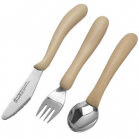 |
 |
 |
- Hands should be pointing down towards the plate.
- Show your child how to point their index fingers down the knife and fork, using their “pointy fingers” to push down more strongly.
- Their other fingers need to stay wrapped tightly around the handle.
Try breaking the activity down into steps
- First, get a good grip on the cutlery with it pointing upwards
- Get your “pointy fingers” in the right place
- “Stab” (push) with the fork
- “Saw” with the knife (backwards and forwards motion – no tearing)
More ideas
- Practice using a knife and fork during fun activities, for example, play-doh or cookie dough, or their favourite food.
- Use a hand-over-hand technique by standing behind and placing your hands over theirs to guide while cutting. This allows your child to feel the movements needed for cutting.
- It is easier to practice cutting with soft foods, such as fish fingers, boiled potato, well-cooked vegetables. Cut round food (for example, potatoes or sausages) in half to stop them rolling around the plate.
- Gradually increase the amount of cutting they do. Allow extra time for practice. Make a deal with your child about the number of items they cut or how many times they try before you help them. This can be increased over time as they become more skilled and confident. Practice little and often.
- Many children need ongoing adult prompting to maintain their hand position and cutting technique, try asking questions about what they need to do, rather than giving instructions. Demonstrate how you use your knife and fork and make it obvious.
- Support your child to come up with a plan, how can they complete this task?
What will help them remember? What comes next?
- Use a reward chart to record and praise their achievements at each step.
Showering and bathing: Top tips for children
Showering and bathing: Top tips for children
- Many children need ongoing adult prompting to maintain their routine.
- Help your child to come up with a plan that works for them.
How can they complete this task? What will help them remember? What comes next?
- Break the task down in to small steps. Encourage your child to join in with very small parts of the routine, gradually increase how much they do.
- Use ‘chaining’ (see our introduction to getting dressed leaflet), if they struggle to start the task, you start things off and encourage them to do the final step. This also works if your child can start the task but struggles to complete all the steps – you take over.
- Use a reward chart to record and praise their achievements at each step.
Lots of ideas are given below. Try different things to see what works for your child. Read ‘Daily Living Skills: Top tips for parents and carers’ which may also be useful when thinking about the best approach.
Where do I start?
Environment and preparation
- Allow extra time. Think about what your child is doing before and after the activity, prepare them for a change of activity and what will happen afterwards, this can be motivating.
- What do you need now? (towel, clean clothes, toiletries).
- Can your child choose their own shower gel, soap, shampoo? (this can be motivating)
- What do you need afterwards? (for example, towel, deodorant, comb).
- Can your child get into the bath safely, can they sit comfortably and in a well-supported position?
- Consider using a step to help your child get in and out of the bath more easily.
- Consider a baby or toddler bath seat if your child is pre-school age.
- If your child is older and is not able to sit safely and independently in the bath, please consider whether an occupational therapy (OT) assessment would be useful for your child. You can find more information about how to refer to occupational therapy.
Washing
- Use a set routine: It is easier to remember what comes next, for example, wash the upper body, then lower body, or name body parts.
- Work from the top of your body downwards (or vice versa) each time: This acts as a memory prompt to wash everywhere.
- Use visual prompts to remind you and your child of the different tasks and the order
- Use a sponge, flannel or shower scrunchie: This makes it easier to lather and spread the shower gel or soap.
- Check: Does your child think they are clean? Have they washed and lathered everywhere? Have they rinsed well?
Hair washing
What steps are needed?
Try to keep techniques used consistent:
Wetting hair
- How long for?
- Could you use a timer?
- Do you need a jug to pour water on?
Getting the shampoo ready
- How much do you use?
- Could you use a measuring cup or spoon?
- How big should the blob of shampoo be?
Lathering shampoo
- How long for?
- Can the shampoo be applied in smaller blobs in different places (front and back)
- What kind of hand movements are needed to lather?
- Could you start at the front and work backwards, or vice versa?
- Can you use hand-over-hand to guide the movements?
Rinsing
- How can your hands help?
- How to rinse? Jug or shower?
- How long for?
- How to check hair is clean?
If your child does not like getting water in their face, remind them to:
- tip their head back
- close their eyes
- try a shower visor or shampoo guard
Drying
- Use a set drying routine, do things in the same order each time.
- Use hand-over-hand to demonstrate drying technique.
- Drying is often easier when sitting, for extra stability.
- Use a smaller towel (for example, hand towel) which is easier to hold and handle. Children can struggle to use bath sheets well.
- Wearing a towelling dressing gown is a great way to get dried.
- Encourage your child to think about how they know when they are properly dried.
What comes next?
Comb hair and get dressed. See our other leaflets for help with different tasks
Introduction to dressing skills
Introduction to dressing skills
This is an overview of general ideas that can help. Learning to dress is a complex skill which requires lots of regular practice and can take time. Encourage your child to do as much as they can for themselves.
Where do I start?
Environment and preparation
- Quiet room
- Have everything you need ready, including any visual prompts, for example, picture sequence
- Talk to your child about what you are going to do before you start
- Start with undressing, this is easier than dressing.
- Sit somewhere comfortable and stable where your child is supported, this makes it easier to think about the task in hand and not balancing.
- Put things in the same order and use the same techniques/routine each time.
Timing
- Go at your child’s pace
- Give lots of praise for practising skills even if they are not successful at completing the task straight away.
- Break it down and take things one step at a time, further information about the different aspects of dressing can be found below.
- Little and often can be better than spending a long time practicing one thing.
- Let your child do it themselves sometimes, they may do more when left alone.
Clothing
- Use loose fitting clothing with elastic waists, wide neck and arm holes.
- Ensure clothes are the right way round before starting.
- Talk about what you are doing as you are doing it, asking questions encourages independent problem solving.
Being aware
- Encourage your child to look at what you and they are doing.
- Encourage your child to look at themselves (maybe in a mirror) and decide if everything is right, if not, can they work out what is wrong themselves?
Techniques for learning dressing skills
Adapt the clothing
Could the items used for the task be more straightforward whilst your child is learning? For example, looser clothing, bigger buttons.
Change the environment
Could the environment or surroundings be changed to make the task easier?
- Quieter room
- No TV
- Reorganising where things are kept
- Can your child sit down to complete the task?
Grading
- Break the task into small steps and gradually involve your child more over time.
- It’s ok to start very small and provide some support.
- Encourage the next step in the task when they are ready.
Backward chaining
Here the adult begins the task, with the child only doing the last step. Gradually the adult does less as the child can do more for themselves. This way they always gets the reward of finishing the task, for example, you put the t-shirt over your child’s head and help them to get their arms through the holes. Your child then pulls down the t-shirt at the front and gets their reward!
Forward chaining
This is when the child starts the task (for example, putting the t-shirt over their head), and the adult helps with the later stages where more help is needed (for example, putting their arms through the sleeves). Your child needs to be motivated to begin the task themselves for this approach to work.
Visual prompts
- Using a sequence of photographs or symbols to support a dressing routine can be useful for some children.
- Encourage your child to look at the visual prompts at each step and consider what they need to do.
Problem solving approach
- Asking questions rather than instructing or telling encourages independent problem solving and supports the child to come up with their own strategies for dressing successfully.
- For children aged 6+ who have good communication, an “ask don’t tell” approach could be used to support independence in dressing skills.
- For example, ask your child:
- what comes next?
- what would help them remember?
- is each step is complete? Encourage checking appearance/neatness and whether items look or feel right.
Hand over hand
This involves standing behind or next to the child and placing your hands over theirs. You can then physically assist them with gripping, pulling or completing the movements that the task requires, for example, pulling on socks.
Dressing: Upper body
Dressing: Upper body
Tops, jumpers, coats
Are clothes the right way round?
- Wear tops with a picture on the front. Point out the picture or ask them to find it.
- Put a coloured label on the back of the clothing. You may also want to remove other labels, for example, in the side seam of knickers. Encourage the child to find this to help them find the back.
Mark a key point to help
- Use stickers, permanent marker or a stitch of colourful thread to mark a key point on the item.
- Think about where will be easiest to spot the mark.
- Keep it consistent, mark all garments in the same place, in the same way.
- Ask questions: what’s on the front? Where is the tag?
Get a good grip
- Roll up the bottom, back edge of the clothing to give a good grip.
- Use hand over hand to help your child hold on to the right bit.
- Avoid slippery fabrics.
Can you find the arm and head holes?
- Lay clothes out flat in front of your child.
- Arms in first.
- Next, look and find the head hole.
Coats
- Choose a coat with a contrasting lining.
- Ensure coats are loose fitting, even when wearing jumpers or layers.
- Putting their nondominant arm into the coat first is helpful, their “best” arm is then still free to make the task easier.
- Put the hood on first, this means the coat sleeves are freely hanging and both hands are free.
- Drape the coat over the back of a chair with the lining facing outwards and sleeves hanging. Your child can then put each arm into the sleeves with their back to the chair.
Buttons
- Start practising with larger, flat buttons and move onto smaller ones.
- Practice with the garment on your child’s lap or on the table in front of them initially.
- Start practising with larger, flat buttons and move onto smaller ones.
- Use a “push and pull” method to fasten buttons.
| Push | Pull | Pull |
|---|---|---|
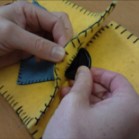 |
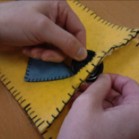 |
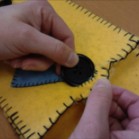 |
- Is the button hole large enough for the button?
- Only undo the top 2 to 3 buttons when taking off a shirt and then pull it over the head, reducing the amount of fastening needed.
- Use Velcro instead of buttons, for example, on a shirt use Velcro and sew buttons onto the top flap.
- Leave the cuff buttons done up, or try sewing a button attached with elastic across the cuffs, this will stretch when the hand is pushed through.
Zips
- Test zips before buying for ease of use.
- Attach a key ring or tab to the zipper to help with gripping.
- Break the task into small steps: For example, pull the zipper down, slot the zip into the zipper, hold the bottom of your coat, pull it tight, pull the zipper up slowly.
Dressing: Lower body
Dressing: Lower body
Trousers, skirts, socks and shoes
Trousers, skirts and pants
- Get a good grip: Use hand over hand to help with hand placement and grasp, pulling up or pushing down clothing.
- Choose trousers or skirts with an elastic waist band if buttons and clasps are tricky.
- Encourage looking for leg and foot holes before starting, lay out the clothes flat.
- Are the clothes the right way round? Put a coloured label on the back of the clothing. Remove other labels, for example, in the side seam of pants. Use items with logos or pictures on the front.
- Use questions to prompt with self-checking, use a mirror if needed. This can be useful for tucking in shirts and making sure waistbands aren’t twisted.
Buttons and clasps
- Clasps and buttons on trousers and skirts can be difficult, especially as you can’t see clearly when fastening them. Practice with the item on your child’s lap or in front of them on the table.
- Make sure waistbands aren’t too tight, this makes fastening clothing much more difficult.
- Start practising with larger, flat buttons and move onto smaller ones.
- Use a “push and pull” method to fasten button.
Socks and tights
- Avoid tight fitting socks.
- Choose socks with different coloured toe and heel, as a prompt to help with getting toes and heel in the right place.
- Mark the back of the sock with colourful thread on the inside top edge.
- Roll down the top of the sock for ease of grip.
- Sew a loop on the back of the sock for your child to grip and pull up.
- Show your child how to hold the sock and support them to grip it with their thumbs inside and fingers outside, using hand-over-hand if needed.
- Use simple verbal cues such as “thumbs in, foot in, pull up”.
- Roll tights down and use hand over hand to support your child to hold them.
- Place their foot and toes in first, and pull up.
Shoes and shoe laces
- Use stickers or markers inside or on shoes to help with identifying the right feet.
- Flat laces are easier to tie. Ensure that the laces are long enough to comfortably tie a bow.
- Practice with two different coloured laces tied together and laced into one shoe. This helps when starting to cross the laces over.
- Practice with a shoe on the table in front of your child, or with it between their knees so it is easier to reach.
- Make a plan for shoelace tying by breaking the task down into very small steps and practicing each step.
- Can they think of a silly rhyme, story or poem to help remember the different steps and actions? Use their ideas!
- Alternatives to shoelaces include Velcro fastenings, elastic laces, springy-spiral laces, slip on shoes.
Bike riding: Top tips for children
Bike riding: Top tips for children
Riding a bike is a complicated skill to master. To ride without stabilisers, your child needs to be able to pedal forwards continuously, having practised on a trike or bike with stabilisers. Riding a scooter or balance bike can develop the balance, strength and steering skills needed for bike riding. The following tips are to help your child learn to ride without stabilisers but the same principles can be used to teach bike riding with stabilisers.
Choosing a bike
- Make sure your child’s feet touch the floor and they can comfortably reach the handlebars and brakes.
- If they are unable to straighten their legs when the saddle is at its highest, consider the next size up.
- Go to Halfords or your local bike shop if you need help choosing or adjusting the bike, or adapting a bike for a child with a disability.
Safety equipment
Your child will need:
- a well-fitting helmet, sturdy footwear and reflective clothing.
- adding a belt to their trousers will give you something to hold onto when they struggle to balance. A handling belt can help you support a bigger child.
Where to go
- Look for an open, quiet area in your local park. A slight downhill can aid momentum in the early stages. Look for a firm and even surface.
- Learn to ride sessions are run by Cycle North during school holidays.
- Adapted bike sessions are held at The John Charles Centre for Sport.
- Research local charities and projects for cycling activities and second hand bikes.
When to practise
- When you have a period of time to commit to regular practice, such as the school holidays.
- When your child wants to learn.
- Practise daily if possible for 20 to 40 minutes: Long enough to develop their skills without getting tired or frustrated.
Bike handling
- Encourage your child to be as independent as possible when fastening their helmet, picking up the bike, pushing it along, turning, and using the brakes.
Learn to ride programme
- Remove pedals to develop scooting skills, or use a balance bike. Mark the pedals left and right to avoid confusion when replacing them. Practise scooting with alternate legs first, then lifting both feet off the ground for a few seconds. Once they have got the hang of this, put the pedals back on.
- Learn how to mount the bike. Place both hands on the handlebars whilst squeezing the brakes. Standing on the ‘clean’ side (opposite side to the chain), straddle the bike to sit on the saddle. Make sure the bike fits well and feet touch the ground.
- Practise getting the pedal ready. Using the preferred foot, lift the pedal to a two o’clock position. If needed, hold the saddle to help stabilise the bike.
- Pedal. Run alongside the child while they pedal, holding their waistband, belt, handling belt, or saddle, whichever works for you. Identify a long straight stretch with a clear start and finish and go fairly fast.
- Practise braking. Remind your child to squeeze the brakes and put their feet down.
- Pedal independently. Reduce physical support by letting go intermittently whilst staying close. If they start to lose balance, help to realign them or break their fall. Gradually reduce support so they learn to make adjustments.
- Practise setting off independently. Remind them to get the pedal ready, keep arms straight, look ahead, and push down hard on the pedal.
- Ride in a straight line without support. Remind them to look ahead and go fairly fast.
- Practise braking suddenly.
- Practise riding in circles and turning corners. Once they have mastered these, set up a slalom course with markers.
Child top tips
Use these simple verbal instructions to remind them what to do
- Pedal ready.
- Look ahead.
- Go fairly fast.
- Sit tall, arms straight.
- Feet down.
Toileting: Top tips for children
Toileting: Top tips for children
Early skills
Your child needs to be developmentally ready for toilet training
- Can they get onto the toilet and balance?
- Do they know what the toilet is for?
- Do they show awareness of being wet or soiled?
- Can they communicate their needs?
- Can they stay dry for an hour?
You may need child-friendly equipment, for example, potty, ringreducer for toilet seat, step up to toilet, big girl or big boy pants, easy access clothing.
Helpful strategies
- Use a reward system: It is essential that your child understands what is expected and that the reward is meaningful and motivating. You could use stickers or tokens or let them choose new pants. Give lots of praise and positive feedback and share successes with important adults.
- Visual cues: Let them see the contents of their nappy and help you empty it into the toilet. Show them that adults use the toilet too. A visual toileting sequence can also help their understanding.
- Grade the changes: Always change your child’s nappy in the bathroom, standing up if possible. Gradually introduce sitting on the potty or toilet with and then without clothing. Slowly increase the amount of time your child sits on the toilet, using toys for distraction.
- Routines: Prompt them to sit on the toilet at set times of the day. Keeping a record of the times they wet or soil will tell you the best times to prompt them to sit on the toilet.
- Speak to your GP if you have any medical concerns or need a referral for specialist support with toilet training.
To achieve independence with toileting, your child needs to manage their clothes, wipe or wash their bottom, flush the toilet and wash their hands without help or supervision.
Wiping top tips
Teaching to wipe
- Use a backward chaining approach: Wipe your child’s bottom and encourage them to do the final wipe. Ask them to check the toilet paper to make sure it is clean. Gradually reduce the number of wipes you help with until they are wiping and checking independently. Put your hand over your child’s hand to guide the direction and pressure they need to wipe. Gradually reduce your hand support but continue to supervise and give verbal prompts.
- Practise wiping at other times, for example, wiping their nose, helping to clean surfaces, and playing games, the wipe clean game can be a fun, motivating way to develop skills. Please see our website for a link to the game.
Too much or too little toilet paper
- Agree how many sheets your child will use and count them out together. Use a rhyme or a picture reminder.
Wiping in the wrong place
- Practise wiping when clean to avoid mess. Check they are reaching to the right place. Use hand over hand guidance if needed.
Difficulty tearing the paper
- Make sure they can comfortably reach the paper. Try using a box of tissues instead.
Difficulty scrunching or folding paper
- Demonstrate and practise how to fold, for example, in half and half again. Show your child how to hold the paper and protect their fingers.
Worried about getting messy
- Use good quality toilet paper or wet wipes (dispose of wet wipes in the bin to avoid blockages). Experiment with different folding techniques, and consider disposable gloves.
Common problems
Unstable on toilet
- A step for the feet can provide stability and good pelvic positioning.
- Try different positions for best stability and reach, for example, standing or squatting to wipe.
Forgets what to do or gets distracted
- Put a visual sequence on the bathroom wall to remind your child what to do next and keep them on track. Try to use questions, for example, ‘what do you need to do now?’
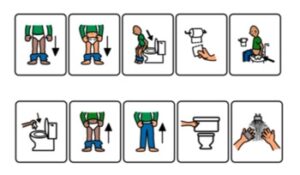
Accidents
- Give prompts at regular times, for example, morning, before bed, after meals. Encourage them to sit on the toilet whether or not they feel the need to go.
- Ensure they can manage their clothes. Adapt fastenings if needed.
Rushing
- Prompt your child to slow down and take the time to check they are clean. Explain that keeping clean prevents smells and sore skin. A social story may help them to understand the importance of toilet hygiene.
Poor motivation
- Set out expectations and encourage your child to participate as fully as possible, for example, adjusting clothing, flushing the toilet, and attempting to wipe.
- Reward independence and effort. You could use a sticker chart or token system tailored to your child’s interests.
Sensory issues
- Reduce sounds and smells by putting the lid down when flushing, using ear defenders, or putting pleasant smells on a tissue/in the room.
- Show your child how the toilet works and make it child friendly with a colourful toilet seat or putting food colouring in the cistern.
Smearing
- Try to unpick why it’s happening and address the problem.
- Is there a medical reason such as constipation?
- Does your child need to develop their wiping skills?
- Do they enjoy the feeling or smell and need more opportunities for messy play?
- Are they avoiding the feeling of the toilet paper or the cold seat?
- Do they find the adult attention rewarding?
- Try to stop it happening in the first place. Keep your child’s hands busy with toys, or use all-in-one bodysuits to prevent access to their pants.
Aiming
- Check your child can reach the toilet easily. Use a step or encourage them to sit down. Stick-on urinals are available for younger boys.
- Check they are looking at what they are doing. Put a ping pong ball or a target sticker in the toilet bowl.
Scissor skills: Top tips for children
Scissor skills: Top tips for children
Using scissors involves a range of skills such as hand eye coordination, vision, attention, using both hands together, dexterity and strength. It takes time to learn and is an important skill for many arts and craft activities which are meaningful and fun!
Pre-scissor skills
- Encourage two handed activities. Start with hands doing the same thing together. Move onto hands doing different things at the same time, for example, using one hand to stabilise when opening jar lids and winding up toys. Then progress to activities such as threading, doing buttons, zips and using a knife and fork.
- Develop grasp and finger strength through play, for example, post boxes, wind up toys, tearing paper and finger puppets.
- Encourage squeeze and release hand movements, for example, using tongs and tweezers, pegs, pinching playdough
and squirt bottles. - Practise snipping straws, playdough, paper edges and making fringes out
of card or toilet rolls. - Practise pushing forwards after each snip by cutting along longer lines.
Scissor skills
- Choose the right scissors: Short blades, small oval holes, rounded ends for safety but make sure they are sharp enough to cut or they will cause frustration.
- It is important to use scissors designed for the dominant hand. Otherwise the blades block the line vision and create tension in the wrong direction. Cut in the right direction, right handers go anticlockwise around a circle and left handers clockwise.
Grasp
- Keep both thumbs on top when holding the paper and the scissors. As a reminder you could paint thumb nails, have a thumbs up sign, or put a sticker on the thumb hole.
- Ideally the thumb and middle finger are inserted in the holes with the index finger on the outside for stability.
- Sit in a good position, tuck in elbows or rest them on the table.
- Turn the paper not the scissors, keeping them straight and cutting away from the body.
Cutting
- Start by cutting along thick lines before gradually making the lines thinner. Draw roads or train tracks to keep within.
- Practise stopping accurately. Draw lines with pictures or stickers at the end to indicate where to stop.
- Use stickers or dots to break the line into sections and prompt turning the paper.
- Practise straight-lined shapes first, moving on to circles and then wavy lines. If the shape is on a large piece of paper, roughly trim the shape first to make it easier to hold.
- Start by cutting thin card before moving onto paper.
- Have a look at free online resources which suit your child’s interests.
- Have a good clean up routine!
Scissor types
Adapted scissors can help children who have a weak grip and poor control. A range of adapted scissors are available from Peta and other retailers. Shop around for cheaper prices!
| Easi grip are good for early snipping. | 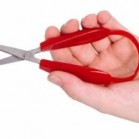 |
|---|---|
| Spring loaded have finger holes and just require a squeeze. | 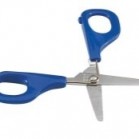 |
| Long loop have a larger hole to accommodate more fingers to increase control | 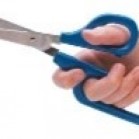 |
| Training scissors have additional finger holes for adults to guide. | 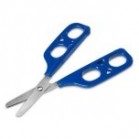 |
| Mounted scissors can be used with one hand. | 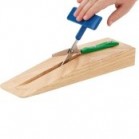 |
Top tips
- Thumbs on top and elbows tucked in
- Turn the paper, not the scissors
- Cut away from the body
- Match the activity to ability
- Have fun.
Children's self care information
Children's self care information
Brushing teeth: Top tips for children
Brushing teeth is an essential part of hygiene and maintaining good health. Some children struggle with the sensory experience of brushing their teeth, or the hand skills and coordination needed.
Top tips
- NHS guidelines recommend that children brush their teeth with fluoride toothpaste at least twice a day: Once in the morning after breakfast and again at night before going to bed.
- Make toothbrushing part of the daily routine as early as possible.
- It is recommended that children have help with brushing their teeth until the age of seven when most have developed the skills required. Children with additional needs may need help beyond the age of seven.
- Encourage your child to have a go at brushing first before you help them.
- Put your hand over your child’s while they are holding the toothbrush to teach them the action and direction needed. Gradually reduce the pressure and guidance you provide as they get more skilled.
- Brushing teeth at the same time as siblings or parents can make it more fun and acceptable.
- Use a timer or sing/listen to a song to teach your child how long to brush for.
- Toothbrushing apps or short YouTube videos may help to engage your child and make the task more fun.
- Electric toothbrushes clean more effectively and reduce the coordination skills needed.
- Multi-directional toothbrushes are available for children who can only tolerate having a toothbrush in their mouths for a short period of time.
- Unflavoured toothpaste is available for children who do not like the taste of regular toothpaste.
Nail cutting: Top tips for children
Some children with sensory differences don’t like having their nails cut. Below are some helpful strategies that can make this activity less stressful for you and your child.
Top tips
- Use scissors or a nail file if your child will not tolerate nail clippers.
- Massage your child’s hand before cutting the nails as this may reduce sensitivity.
- Sitting on a comfortable supportive chair or on an adult’s lap may help your child feel more at ease.
- Cut after a shower or bath when the nails are softer.
- Give your child their favourite toy to play with, put on their favourite TV programme or sing songs together to distract them.
- Cut the nails of one hand/foot at a time and stop the activity if your child is becoming very upset.
- If your child has very low tolerance to having their nails cut, try cutting them while they are asleep
Hair cutting: Top tips for children
The head is a particularly sensitive area to touch which can make hair cutting an uncomfortable and distressing experience for some children.
Top tips
- Touch your child’s head gently but firmly, avoiding light touch when combing, brushing or cutting.
- Encourage your child to help you with their hair care, for example, holding and passing the brushes and clips.
- Provide deep pressure by giving a firm rub down with a towel before cutting.
- Approach from a direction where your child can see you coming.
- Cutting hair in front of a mirror may help as your child can see what is happening.
- Look for a hairdresser in your area who is sensitive to your child’s needs.
- Before hair cutting, prepare your child visually and verbally for the activity. A short social story may help with expectations.
- Set time limits for the activity, for example, ‘we will count to ten and then we will stop cutting’.
- Distract your child using earphones or earplugs to block out the noise of the clippers or dryer, or give them a toy to play with.
- Follow up the haircut with an activity or treat your child enjoys.
Daily living skills for kids: Top tips for parents and carers
Daily living skills for kids: Top tips for parents and carers
Daily living activities include tasks like: dressing, showering or bathing, brushing hair, using a knife and fork and using the toilet.
Daily living activities are complex, they require lots of problem solving, sequencing, big and small movements.
Encouraging children to join in with these tasks facilitates independence and learning; this sometimes means changing the task or your approach.
Remember: All motor skills are learned and children learn differently.
The foundations of daily living skills
Timing
- allow plenty of time, do not rush. When during the day is best to do your practice? Think about what happens before and after self-care tasks and how to prepare and motivate your child.
Environment
- Where are you completing the task, can you minimise distractions?
Tools or materials
- can you use items to make the task easier? (Bigger buttons, easy grip cutlery)
Ability and awareness
- Think about your child’s learning level. Start with small, simple parts of tasks with support, and gradually work from there.
- Set up the task: Put items or equipment in the correct order or support the child to do this with you.
- Follow a consistent routine or sequence, break the task down into small achievable steps.
- Encourage good looking and attention to task: Can you use a timer to demonstrate how long the task will last? What will happen when it is finished?
- Use simple communication and the same phrases or questions.
- Don’t forget to check: Encourage looking, checking and correcting mistakes rather than automatically correcting them yourself.
- Use stickers or points for small steps of each task, these can be saved up and work towards a reward.
Have you tried these methods to support learning daily living skills?
Adapting the tools or materials and changing the environment
Could the items used for the task be made more straightforward whilst the child is learning? For example, cutlery that is easy to grip, looser clothing, bigger buttons.
Can the environment or context be changed to make the task easier? For example, quieter room, no TV, reorganising where things are kept?
Grading
Breaking the task into small steps and gradually involving the child more over time. It’s ok to start very small and provide some support. Keep moving forward with this and encourage the next step in the task when they are ready.
Modelling
Model how you do the different parts of the task and describe what and how you are doing. Refer to body parts, objects, movements and use props to support this. Think about where you sit or stand in relation to the child, for example, shoelaces are easier to demonstrate when you sit next to or reach from behind the child and look at the shoe from their perspective.
Hand over hand
This involves (usually standing behind the child and) placing your hands over theirs to physically assist them with gripping, pulling, completing the movements that the task requires, for example, doing “stab and saw” with a knife and fork, pulling socks over their foot.
Using visual prompts
Using a sequence of photographs or symbols to support a routine can be useful for some children. Support the child to look at the visual prompts at each step and consider what they need to do. Work towards them using these prompts without adult support.
Backward chaining
Here the adult begins the task, with the child only doing the last step. Gradually the adult does less as the child is able to do more of the task themselves. This way the child always gets the reward of finishing the task, for example, the adult puts the t-shirt over the child’s head and helps them to get their arms through the holes. The child then pulls down the T-shirt at the front.
Cognitive and problem solving approach
For children aged 6+ who have good communication, an “ask don’t tell” approach could be used to support independence in many daily activities. For example, asking the child what comes next, where to find this information, whether each step is complete (to encourage checking and amending) and what items look like or feel like. Asking questions rather than instructing or telling encourages independent problem solving and supports the child to come up with their own strategies for dressing successfully.
Practice
This is the most important element of learning the skills needed to be independent in daily activities. Even very short practice sessions regularly can make a huge difference to skills, confidence and motivation for children.
Organisation skills: Top tips for older children
Organisation skills: Top tips for older children
Some people need a little extra support and practice to develop good organisation, planning and time management skills. Below are some ideas and strategies for getting started.
Success in daily tasks gives us a sense of purpose, responsibility and achievement. To plan and successfully carry out a task we need to ask the ‘Who, What, Where, When, Why and How’.
Preparation for the school day
Morning routine
- Have your own alarm clock.
- Allow enough time for your routines (breakfast, washing, dressing, walking to the bus stop) and extra time for the unexpected.
- Agree a bathroom rota in the household.
- Write out a morning schedule on paper, the computer or a whiteboard and put it somewhere visible.
Bag packing
- Empty your bag at the end of each day. Make sure all your belongings have a home. Desk trays and box files are good for organisation.
- Pack your bag the night before and make this part of your evening routine.
- Prepare your lunch, money, bus pass, keys the night before.
- Create a bag packing checklist (using your school timetable) with words or pictures.
- Buy a big enough rucksack with lots of sections/pockets, for example, holder for water bottle.
- Carry only what you need!
- Refer to your own calendar for homework deadlines, PE days and events.
School day
Following your timetable
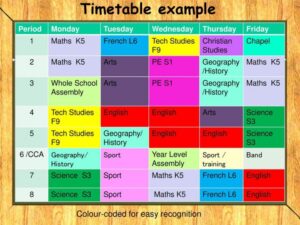
Customise your timetable:
- Colour code your timetable to match your work books, for example, English = red.
- Use a visual (picture) timetable if this is easier to read.
- Make more than one copy: Keep one by your home desk, one in your planner, one in your pencil case or wallet and a spare one.
Remembering important information
- Use your planner: Write reminders and create to do lists in a note pad.
- Choose an easy access compartment in your bag for the most important things, for example, planner, timetable, letters.
- Keep an A4 file with dividers in your bag. You can file your work into subject folders when you get home.
- Write your name and date on the top of each page.
Timekeeping
- Know what’s next and what’s after that! Check your timetable before break and lunch.
- Go to the toilet, fill up your water bottle and collect your books before the end of break.
- Wear a watch. You could set an alarm 5 minutes before the end of break.
Organising and planning your work
- Make a note of any questions you have during the lesson to ask at the end.
- Use spider diagrams or post-it notes to organise your ideas.
- Use different coloured pens.
- Record your ideas using a dictaphone, a scribe or a computer if recommended.
- Draft a plan of your work.
Ask your teacher to:
- Break down instructions into steps. You can tick them off when completed.
- Use simple language. You could highlight key words with a marker.
- Repeat instructions. You need to be prepared to ask.
- Write down key information. This could be on a board or a handout.
- Give you time to process information.
- Check your understanding. Could you explain it to someone else?
- Minimise distractions. Sit near the front and next to someone who works well.
Organisation in lessons
- Have the right equipment:
- Make a list of the equipment you need, for example, compass, calculator, lab coat.
- Unpack everything you need at the start and check the desk is clear before you leave.
- Use a clear pencil case so you can find things easily.
After school
Homework
- Ensure you understand the homework instructions:
- Allow time to check with a friend or teacher that you understand what you need to do.
- Record your homework and deadlines in your planner. Transfer your deadlines onto your calendar at home.
- Ask for a handout or email from the teacher, or permission to take a photo of the board.
- Have a homework routine and set a realistic timeframe:
- Agree a good time to fit in with your family when someone is available to help if needed.
- Plan around your energy levels and other commitments.
- Consider a homework club or study buddy to help with motivation.
- Make a distraction-free workspace: Minimise objects on the desk, have everything you need, consider siblings’ homework routines and make sure you’re sitting well.
- Write out a homework plan or to do list. Start with the easier tasks, take breaks, decide when you will stop and give yourself a reward at the end.
Organisation skills at home
- Take on roles and responsibilities: feeding the pet, doing laundry, preparing meals and setting your own reminders on your phone or calendar.
- Your parent or carer could help you by:
- Showing you, watching you and then stepping back.
- Breaking down tasks into steps.
- Encouraging you to use your strategies, for example, checklists, written instructions, visuals, alarms.
- Asking not telling, for example, ‘what do you need to do next?’
- Agreeing expectations and rewards.
Top tips
- Make a plan
- Write things down
- Have a place for everything
- Keep track of time
- Practise my skills and use my strategies
Everyday baby essentials for eating, bathing, sitting and playing
Everyday baby essentials for eating, bathing, sitting and playing
Playing
Playing in different positions with a variety of toys, will help all aspects of your child’s development and prepare them for developing independence in activities of daily living.
Top tips for developing finger control
- Ensure your child is well supported in any position they are comfortable in.
Early play skills
- Choose rattles that are easy to grasp and transfer from hand to hand, and hand to mouth, and have a range of textures.
- Play gyms encourage reaching up with whole arm movements which are important for developing hand control.
Later play skills
- Choose toys that have holes in to encourage your child to use their index finger (poking action).
- Choose toys with buttons or parts to twist, turn, pull and push.
- Choose toys that involve, stacking, sorting, posting, putting things in or out. These will help your child to learn how to let go, match shapes, and develop a range of grasps.
- Give your child opportunity to experience different textures within their play, for example, sand, water, playdough, dry pasta.
- Household objects, such as pegs and wooden spoons, can also provide great play experiences for your child.
Sitting
Spending time in a well supported sitting position allows children to develop their hand skills so they can play and join in other everyday activities, such as feeding themselves and getting dressed.
Different sitting positions are useful at different ages, and for different activities.
The following chairs are examples of seating, separate from your child’s car seat, that are available in mainstream shops.
Early sitting (0 to 9 months) top tips
- Baby bouncers with a deeper seat will help your child’s hips to stay in a better position.
- Look for a baby bouncer that keeps your child’s head, tummy and hips in the middle.
- Look for a baby bouncer that supports your child’s shoulders, and helps them to bring their hands forward, in line with their vision.
- Additional padded support may be required initially.
NOTE: Using a car seat for long periods of time in the home may restrict your child’s movement and vision and delay independent sitting balance.
Floor sitting top tips:
- Use more supportive positions if you are focusing on developing play, vision or hand skills.
- Use less support if you are focusing on developing their sitting balance, and use toys that require less effort.
- Using different positions throughout the day for different activities gives the best opportunities for development.
- Some seats can be useful for short periods to help children to participate in activities with friends and family.
- Avoid propping your child with cushions on the family sofa.
Inflatable or cushioned floor supports are good for children who have just developed head control and early sitting balance, and no longer need to rely on their arms to prop on the floor.
Baby snug chairs and other floor sitters with play trays and straps can work well to help your child develop their hand skills and interaction in a safe and supported position.
Chairs like these should only be used following manufacturer guidelines and when your child has developed some head, neck and trunk control.
Note: Some children will arch back when tired of sitting, supervise your child at all times when in a chair.
Box sitting top tips:
- Your baby needs to experience sitting with their knees in line with their hips, and their feet flat on the floor (box sitting, or chair sitting position).
- Sitting on a small stool or booster seat on the floor, helps your child to develop better use of their leg muscles in preparation for standing.
Both of these booster seats are available from high street stores such as Boots, Tesco, Mothercare, and online from Amazon.
Highchairs top tips
- Use sturdy hip strap and pommel, to prevent child slipping forwards.
- Use over-shoulder straps that fit snuggly.
- Allow narrow gap between your child’s tummy and the tray.
- Hips and knees at right angles, so that your child is in an upright position for swallowing safely.
- Shoulders, arms and hands should be forward, so they naturally rest on the tray.
- Avoid highchairs that are fixed in a reclined position.
- Look for a highchair that can be brought as close to the family dining table as possible, to encourage your child to develop their social interaction skills.
- Use rolled up towels, or pieces of foam to add additional support if needed.
- Highchairs can be a place for play, as well as feeding.
Bathing
- Independent sitting and good sitting balance often develop later in children with delayed development.
- You may feel more confident letting your child play in the bath if you use something to support them.
- Bath time should be a fun place for you, your child, and their sibling to play together, and playing with bath toys is an excellent way to develop hand skills.
- As sitting balance develops, seats that support round their tummy help your child play in the water.
0 to 9 months: Reclined seat with pommel. You need to be able to lift your child out of this type.
Even with support, never leave your child unattended.
Toileting
Children with delayed development sometimes struggle with balance and stability which may affect their confidence and comfort on the toilet.
When using the toilet, something to support their feet and something close to hold onto with their hands may be all that is required to make them feel safe.
Early potty training
Choose a potty chair that has a high back rest, handles or arm rests and allows your child to sit with their feet flat on the floor.
When your child can use the toilet, you can either use a seat and step combination, or a separate insert with a handle and foot stool.
Feeding
Children with delayed development often begin feeding themselves with their fingers at around 10 to 12 months old.
Between 12 to 18 months, they will begin to take interest in holding their own spoon.
Feeding skills develop best when children are sitting in a comfortable, and well supported position.
Top tips for developing cutlery skills
- Use child size spoons with thick, easy grip handles that curve inwards and have flat shallow bowls.
- Avoid spoons and forks with thin narrow handles.
- Use children’s dishes with raised sides, so that your child can scoop the food against the side of bowl.
- Give hand over hand help to begin with to learn the scooping motion to bring the spoon to their mouth or stabbing motion for using a fork.
- Gradually reduce the amount of assistance you provide.
- Use textured foods that will stay on the spoon easily to practice with initially, for example, mashed potato, fromage frais.
Get messy
This helps children to explore, learn and refine their skills. Messy play ideas, jelly, angel delight, yogurt, baby food.
If in doubt about your child’s ability to eat certain foods, or if you are concerned, they aren’t swallowing properly, consult your health visitor. A speech therapy feeding assessment may be advised.
School resources
How can I support my students to develop early writing skills?
How can I support my students to develop early writing skills?
Who is this information for?
Teachers, teaching assistants, parents (for support with homework).
Which students may need support with this?
Students who are at the early stages of pencil skills and students who are learning to form letters and numbers. This is typically for the student under 7 years old or for older students with a learning
disability.
For children who have mastered forming letters please see our information on:
- ‘How can I support my students to write with ease’
- ‘How can I support my students to form letters and present their work’
What can I do and how will this help?
Students need to recognise numbers and letters if they are to form them in a meaningful way. Research recommends a multi sensory teaching method. This involves teaching a letter or number in many different ways with the goal of working towards the student forming their letters. Students should practise using big movements to help understand how letters are formed. Be creative, use a stick in the sand, a finger in shaving foam, or a paint brush and water outside on the ground. Use different and fun ways to help make learning more enjoyable.
Does the student need you to demonstrate the letter formation?
Draw the shape in the air, or on a whiteboard first, then practise on paper. Research suggests a minimum of 20 practice sessions are needed to develop this skill. Practice little and often.
Does the student need to feel the direction of the letter formation?
Practising tracing over raised letters with the finger can help learn letter formation. Making letters from different textures such as sandpaper, string, or in the groove of a cut out letter or stencil can all be useful.
Does the student need to talk through the letter formation?
Talking through the direction of the movements as students practise letter shapes, for example, go ‘up around and down’ will help the student to remember. Making up rhymes or words to help remember the formation can be useful.
Does the student need opportunities to recognise and pick out letters?
Look around the classroom trying to find as many shapes, letters or numbers like the ones they are practising to help them remember the shape.
Does the student need opportunities to develop pencil control?
Students with early writing skills need time to learn how to control their pencil to make meaningful shapes practising with pre-writing patterns. A programme which builds on this is ‘write from the start’.
Where can I get more information?
To get resources to help students with developing early writing skills check out the following websites or search the internet for other similar resources.
- Tactile letters
- Write from the start
- Squidgy letters
The ‘Write from the start’ programme focuses on early pencil control along with the later part of the book focusing on letter formation.
For further advice and guidance on teaching early writing skills see the Canchild website and look for pre-printing resources in the DCD (developmental co-ordination disorder) resources.
Contact us
For further advice and to tell us what you think of this information:
- Address: Children’s Occupational Therapy Service
Integrated Children with Additional Needs (ICAN)
Leeds Community Healthcare NHS Trust - Phone: 0113 843 3620
- Email: central.spa1@nhs.net
How can I support my students to form letters and present their work?
How can I support my students to form letters and present their work?
Who is this information for?
Teachers, teaching assistants, parents (for support with homework).
Which students may need support with this?
Students who are still learning to:
- form letters
- leave spaces between words
- write letters the same size
- keep their words on the line
What can I do and how will this help?
When students are still learning to write, it takes a lot of effort to remember the letter shape and control the pen or pencil. You may therefore see a dip in the quality of their handwriting when they are needing to complete pieces of independent work.
Students will need regular teaching and practice at handwriting. Research suggests a minimum of 20 taught sessions are needed. There are different ways you can support students:
Does the student need extra practice to form letters clearly?
Students need to practise ‘little and often’ to help them remember how to form letters. Students often benefit from practising letters within a ‘letter family’. An example of this is the letter ‘c’. Forming this letter can then lead into forming a letter ‘a’ and then the letter ‘d’ and so on.
The student is learning to start at the same point each time to help remember how letters are formed. This is also recommended in the National Curriculum guidelines (revised July 2014). Research suggests students 7 years and older benefit from direct teaching and a problem solving* approach to developing handwriting. Examples of this type of approach include:
- Grade the task so that you just work on one little bit at a time, for example, one letter from a word, or one stroke of an individual letter.
- Ask the student to look at a letter they have formed and one you have formed, and ask questions such as, what is different between mine and yours?
- If the student is struggling to see how they are going wrong and how you are doing it more effectively, demonstrate forming the letter and make it really obvious how they are going wrong, so they work it out for themselves.
- Use words or rhymes to help them to visualise the letter or remember a series of steps or rules. It is more powerful if the student comes up with these ideas themselves.
Students under 7 years old and some students with learning difficulties benefit from a more mulit-sensory way of learning. This could be practising letters in sand with a stick to draw with or with their finger using shaving foam. See our information on ‘How can I support my students to develop early writing skills’.
Does the student need help to start at the left hand side of the page?
Having a dot to help them remember where to start point can be useful. For example a green dot on the left side of the page for ‘go’ and a red dot at the end of the line to stop writing.
Does the student need a finger spacer?
If the student is working on remembering to leave a space between their words, a finger space can be useful.
Examples of finger spacers include using a lolly pop stick, or searching on the internet for downloadable ones to cut out and laminate.
Does the student need extra visual prompts?
For students who need to practise using capital letters and full stops, having a laminated prompt card with these simple reminders on can be useful so the student can learn to check their work and make the changes.
Does the student need to write on different paper?
For students who need to practise where letters sit on the line, paper with extra lines can help. Practising on paper with extra lines can help students see where ‘tall’ and ‘tail’ letters sit in relation to each other such as ‘d’ and ‘g’.
Where can I get more information?
For more information on supporting students with handwriting in class see the following information on our webpage:
- How can I support my students to gain pencil control?
- How can I support my students to sit well in class?
For more resources on letter formation, finger spacers and other visual supports, visit Sparklebox or Twinkl.
For further information on handwriting and letter families, the Canchild website has lots of useful information within its DCD (developmental co-ordination disorder) resources.
Contact us
For further advice and to tell us what you think of this information:
- Address: Children’s Occupational Therapy Service
Integrated Children with Additional Needs (ICAN)
Leeds Community Healthcare NHS Trust - Phone: 0113 843 3620
- Email: central.spa1@nhs.net
How can I support my students to gain pencil control?
How can I support my students to gain pencil control?
Who is this information for?
Teachers, support workers, parents (for support with homework).
Which students may need support with this?
- Students who are learning to grip a pen or pencil
- Students who are learning to press on with the right amount of pressure
- Students who are learning to write more legibly
- Students who are learning to write more and finish work
- Students who want to increase the comfort in their hand when writing
What can I do and how will this help?
There are lots of small changes that can be made to support students to gain pencil control. Students should have regular practice using some of the suggestions below.
Does the student need a pencil grip or thicker pencil?
A student may press down hard when writing because of a weak grip. Gripping tightly may help them to control their pen or pencil when writing. This can often make the student’s hand ache and they may need to shake their hand to relieve this feeling. A grip or thicker pencil is often more comfortable to hold, so the student doesn’t have to grip too hard.
Does the student need to use a pen?
A pen often glides more easily than a pencil when writing. This means the student will need to grip less tightly when writing. Try the student with a thicker pen and one with a built in grip to make holding the pen more comfortable.
Does the student need to use a writing slope?
A writing slope can help with pen or pencil control by supporting the wrist and forearm. It can also encourage a
more comfortable upright sitting posture.
Does the student need to record school work on a computer?
If the student needs to record school work, and handwriting is not progressing for them, consider using a computer. It is important to make a plan for practising touch typing, using the computer in lessons and printing off their work. Research suggests students will need 25 to 30 hours of teaching and ongoing practice.
Does the student need to use other ways to record their school work?
If the student is not progressing with writing and typing following practice, they may need to look at other ways to record their school work. This could include:
- Using gapped worksheets, if the student’s handwriting is easy to read but writing longer pieces of work is effortful.
- Using a scribe. Telling someone else what to write is often difficult for children to do. It is important to make a plan to practise this and build it into the school day.
Where can I get more information?
See the following tabs on this webpage:
- How can I support my students to sit well in class?
- How can I support my students to develop early writing skills?
- How can I support my students to form letters and present their work?
To write or to type, that is the question!
For further information, visit the Canchild website which has lots of useful information within its DCD (developmental co-ordination disorder) resources.
Contact us
For further advice and to tell us what you think of this information:
- Address: Children’s Occupational Therapy Service
Integrated Children with Additional Needs (ICAN)
Leeds Community Healthcare NHS Trust - Phone: 0113 843 3620
- Email: central.spa1@nhs.net
How can I support my students to sit well in class?
How can I support my students to sit well in class?
Who is this information for?
Teachers, teaching assistants, parents (useful for homework and meal times etc).
Which students may need support to sit well?
All students need to sit well. If a student has to concentrate on sitting well this will make it hard to concentrate on their school work at the same time. The following students may need support:
- Students with low muscle tone (often seen in children who slump at their desk, or wrap their legs around their chair legs) to increase comfort and stability
- Students learning to stay focused (can sometimes be seen fidgeting or getting up from their chair)
- Students learning to write or progress with writing
- Students using a computer
What can I do and how will this help?
By making changes to the classroom environment the student will be able to feel more comfortable completing their schoolwork. This will help the student to complete their schoolwork with more ease. The suggestions below will help to increase the student’s comfort, focus and work produced.
Does the student need their table swapping?
Students should be able to place their elbows around 90 degrees to the table. A table too high and the student may find it difficult to control a pen or pencil or type on a keyboard. A table too low and the student might slump over the desk, causing a poor posture. A height adjustable table may be needed.
Does the student need their chair swapping?
Students should be able to place their feet flat on the floor when sitting on their chair (knees and ankles at 90 degree angles). This will enable them to sit comfortably. A chair too high and feet may dangle and the student will focus their attention on trying to balance. A chair too low and they may not be able to reach the table.
Does the student need a footrest?
If a more appropriate chair is not available and the student’s feet do not touch the floor, place an upturned box or similar under their feet as a rest.
Does the student need to improve their position at the desk?
Make sure the student’s chair is tucked in close to the table so that their tummy is almost touching the table, and their back is well supported in the chair. This will help to promote a good upright sitting posture.
Does the left handed student need to sit in a different position in the class?
Left handed students should avoid sitting on the right side of the table next to a right handed student as both will be using writing hands next to each other leading to possible bumping of arms and impacting on handwriting. Sit a left handed student on the left side of the table.
Does the child need to use a move n sit cushion?
Students working hard to sit upright at the table may have low muscle tone. Providing them with a move n sit cushion can help to place them in a more upright position by tilting their pelvis forwards. This gives a better position for completing table top work.
Also students who need to fidget to help them concentrate and complete work can move around on the air filled cushion. This helps them without distracting other students sat at their table.
Where can I get more information?
For more information on equipment, see the following websites or search for other suppliers:
Contact us
For further advice and to tell us what you think of this information:
- Address: Children’s Occupational Therapy Service
Integrated Children with Additional Needs (ICAN)
Leeds Community Healthcare NHS Trust - Phone: 0113 843 3620
- Email: central.spa1@nhs.net
How can I support my students to stay focused in class?
How can I support my students to stay focused in class?
Who is this information for?
Teachers, teaching assistants, parents (for support with homework).
Which students may need support with this?
Students who:
- Are working towards getting started more promptly with school work
- Are working towards keeping going with school work
- ‘Switch off’ and ‘daydream’
- Are easily distractible
- Are fidgety
What can I do and how will this help?
Students need the best classroom environment to be able to complete their school work and demonstrate their full potential. For some students changing a teaching environment to meet their learning needs, can help to address the above.
Does the student need fewer visual distractions?
Most students enjoy lots of pictures in the classroom and use many of the visual aids around them to support their learning. However, it can prove a little ‘too much’ for some students. These students can struggle to select only that which is relevant. Some students can find themselves getting distracted by the resources available and therefore ‘tuning out’ of the lesson. You can support the student by:
- Placing their desk away from wall displays
- Having a quiet workstation with built up sides to filter out distractions
- Thinking about who would be a good working partner to sit with
Does the student need a movement break?
Some students need to do something a little more physical to keep their attention levels up. This is often seen in the fidgety behaviour displayed in the classroom. For example when an adult is feeling tired they may have a coffee as a ‘pick me up’. This boost helps an adult to think and complete a task. Teachers can provide students with appropriate opportunities to boost their alert levels to help them focus and complete their school work. Examples include having the student:
- Take a note to another teacher
- Collect in and hand out resources
- Wipe down tables and tidy up
- Complete a physical activity out of the classroom such as running or playing with a ball (if an adult is available to support them)
Does the student need to be seated near you?
This can help you to ensure that when giving out class instructions you know they are focusing and taking in the information.
Does the student need to be asked to repeat the instructions back to you?
This will help to ensure that the student has both listened and understood the information correctly.
Does the student need to have the information written down for them?
Enabling the student to refer back to the information when they have lost their concentration will help them find their place in their work. Providing a list to tick off can be motivating and help students to keep focused.
Does the student need to use a move n sit cushion?
If the student needs to move or fidget to keep alert levels up but needs to remain in their seat, this allows a subtle but constant movement.
Does the student need to have something to fiddle with?
Some children are able to divide their attention and need to touch something to help keep their attention levels up in order to concentrate. This could be a piece of blue tack or a paperclip for example.
Does the student need a timer?
Having a visual support to keep focused such as a sand timer can be motivating and help students to understand the concept of time, for example, ‘you have five minutes to complete your work’ can be difficult for some students to understand. Seeing the time pass can be motivating to attend to and complete school work.
Where can I get more information?
For more information on equipment for the classroom please see the following websites or search for other suppliers:
- Special Direct move n sit cushions (available in two sizes)
- LDA learning fidget pencils
- Special Direct portable workstations
- Special Direct timers
Contact us
For further advice and to tell us what you think of this information:
- Address: Children’s Occupational Therapy Service
Integrated Children with Additional Needs (ICAN)
Leeds Community Healthcare NHS Trust - Phone: 0113 843 3620
- Email: central.spa1@nhs.net


